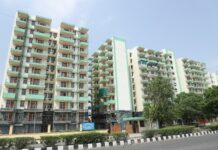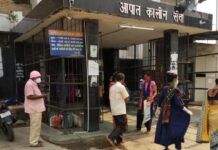[vc_row][vc_column]
[vc_column_text]Recent announcement by Delhi Chief Minister and Aam Aadmi Party (AAP) supremo Arvind Kejriwal regarding his party’s decision to contest Assembly elections in Uttar Pradesh kicked off a debate in the political circles in the electorally crucial state. While a few concede that the party does stand a chance, many look at the move as nothing but a political gambit by a maverick leader.
The AAP, which was born out of Anna Hazare’s India Against Corruption (IAC) movement of 2011 and 2012, is eager to expand its footprint across the country to fulfill its dream of becoming a national party in its quest for power at the Centre. The decision to contest the polls is in line with its national ambition to fill the vacuum left by the Congress after the party’s debacle in the Bihar elections as also in the by-polls held in November 2020.
After a series of drubbings at the hustings, the grand old party is left with no hope of revival leaving alone taking on the formidable rival BJP in the upcoming state elections.
The party is already main Opposition party in Punjab where the farmers are up in arms against the incumbent Bhartiya Janta Party (BJP) led Central government headed by Prime Minister Narendra Modi in the wake of recently enacted farm laws. While almost all Opposition parties are standing by the farmers, AAP’s strident support for the demands of farmers is driven by its political agenda. It will help the party enter the poll fray with a new vigor.
In Goa, the AAP is looking to fill the space for opposition party where the Congress is out of power for a decade. The Kejriwal-led party is also eying Uttarakhand where the electorate tends to bring the Congress and the BJP to power alternately.
Elections in these aforementioned states will be conducted simultaneously in early months of 2022 and the results are expected to be announced in March. Of all the poll-bound states, UP has a huge political significance. With 403 Assembly and 80 Lok Sabha seats, the state is crucial for any political party to have its impact in national politics.
It is too premature to predict performance of the AAP in the polls at this point of time as the elections are still a year away. But regional parties like the BSP, SP, RLD, Congress and other smaller outfits in eastern parts of the state are also eying the polls with a hope of snatching the power from ruling BJP. These parties won’t want to concede an inch to the AAP.
The dynamics of politics in UP are different from that of Delhi. The politics of the state happens to be caste centric. Issues such as law and order and agriculture invariably have an impact on the poll outcome. While the SP relies heavily on Yadav-Muslim combine, the BSP banks on the Dalits and the BJP on upper castes, OBCs and non-Jatav (Dalit). With no segment of the society left untouched by the major political players, it will be an uphill task for the AAP to make a ground for itself in the state.
All the three major parties here are established each having a strong cadre base and roots in the urban and rural swathes of the state. AAP’s poll prospects depend on its promises and projection of its leadership as an alternative to the incumbent BJP.
The party has been voted back to power twice (in 2015 and 2020) in the National Capital. Issues such as free electricity up to 200 units, free water supply up to 20,000 liters a month, free travel for women in the state’s DTC buses, improved education and health infrastructure and graft-free governance has worked for the AAP in Delhi. It is to be seen how best it could market its Delhi’s experiments to woo the UP electorate and find space in political discourse of UP.
It will certainly find some space in the districts bordering Delhi, but to what extent only time will tell. However, as on date, the AAP has to do a lot of groundwork. So far, its presence in the state is minimal, confined to corporations and zila panchyats in various districts of the state. According to a report, the party came fifth after the BJP, SP, BSP, and Congress in 2017 civic polls.
To come to power in a state, any party would need a wave against the incumbent government called anti-incumbency factor in political jargon, which does not seem to be the case in UP with Chief Minister Yogi Adityanath firmly entrenched in the citadel of power. The BJP has performed well in recently concluded MLC elections. It won three of six seats while losing one to the SP and two to independents.
In fact, since 2017, when it was voted to power, the BJP has won all the major polls except Kairana and Gorakhpur by-elections in 2018 when the SP and the BSP had joined hands to defeat the BJP.
Moreover, the AAP needs a leader of Kejriwal stature in the state to match BJP’s Adityanath, SP’s Akhilesh Yadav and BSP’s Mayawati. The party though has declared Rajya Sabha MP Sanjay Singh as its face in the state, his appeal does not go beyond Sultanpur district Singh where he has his roots.
In a sharp reaction to AAP’s decision to contest polls in the state, UP Deputy Chief Minister Keshav Prasad Maurya called it ‘Mungeri Lal Ke Hasin Sapne (pie in the sky)’.
However, a confident AAP has vowed to take the challenge head on. It wants to showcase Delhi’s education and health infrastructure model to woo the UP voters. Recently, Delhi Deputy Chief Minister Manish Sisodia was stopped by state police from going to visit a school in Lucknow. He had embarked upon the journey after accepting a challenge from UP Education Minister Satish Dwivedi to visit the schools the state.
This was widely publicised in through media reports and new channels. This is what AAP seems to bank on for its poll prospects. They will show their Delhi modal and question UP government’s performance in education and health. Interestingly, no Opposition party has spoken a single word about the AAP’s poll prospects. While BJP reacts to every question that AAP raises be it handling of Covid pandemic, health or education.
The war of words between the AAP and the BJP leaders has been on ever since the AAP decided to have forays into the state’s polls. The BJP too wants to create confusion in its detractors as it knows well the more division of votes, the stronger the it will emerge.
The AAP poll prospects depend on what it offers and how it convinces young, floating and anti-BJP voters in the state. It is understood that whatever the AAP gains it will gain on the cost of other Opposition parties. The party has zero Assembly seats in the state. The party’s promises or words should strike a chord with UP voters. In fact, it has a lot of groundwork to do even for getting the Opposition status in the state. Even the status of an Opposition it will be a big boost to the Delhi party to fulfill its pan-India ambitions.[/vc_column_text][/vc_column][/vc_row]
Disclaimer: We do undertake rigorous checks on content provided by contributors before publishing the same. If you come across some factual errors, kindly bring this into our notice and we shall review your objection and claim as per our policy and display correction credits and corrections on the article itself.
The opinion expressed in the article is of the writer. Writer is a freelance journalist/journalist based in Delhi




























